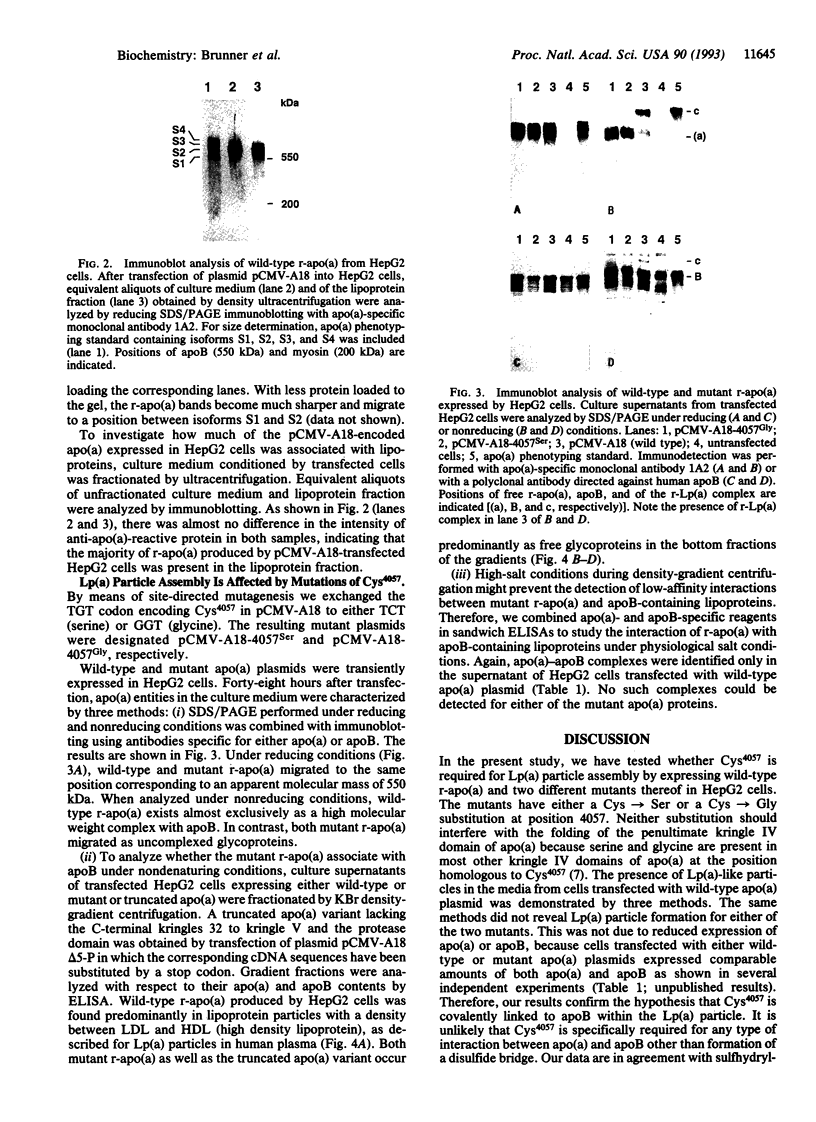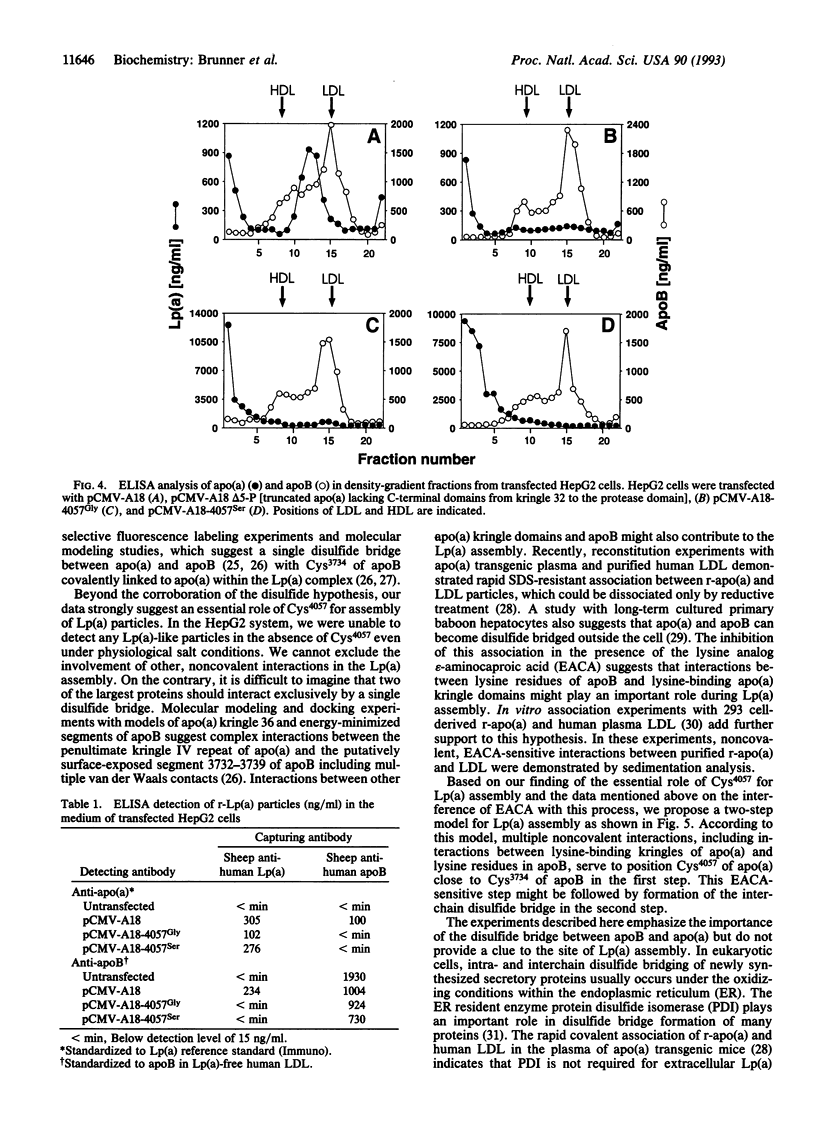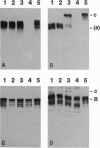Abstract
Lipoprotein(a) contains one copy each of apolipoprotein B-100 and apolipoprotein(a). It has been hypothesized that a disulfide bond might exist between Cys4057 of apolipoprotein(a) and Cys3734 in apolipoprotein B-100. To investigate the role of Cys4057 for lipoprotein(a) assembly, wild-type and in vitro mutagenized apolipoprotein(a) cDNA plasmids were expressed in the human hepatocarcinoma line HepG2. The mutant plasmids encoded apolipoprotein(a) species with Cys4057 exchanged to either serine or glycine. Untransfected HepG2 cells, although able to secrete apolipoprotein B-100-containing lipoproteins, do not synthesize detectable amounts of apolipoprotein(a). After transfection of wild-type plasmid, almost all apolipoprotein(a) in the culture supernatant was present in lipoprotein(a)-like particles as demonstrated by immunoblotting, density-gradient centrifugation, and ELISA. The same analysis performed with supernatants of cells transfected with plasmids mutated in codon 4057 revealed free apolipoprotein(a) glycoprotein without detectable amounts of lipoprotein-associated apolipoprotein(a). Our results strongly suggest the existence of a disulfide bridge between Cys4057 of apolipoprotein(a) and apolipoprotein B-100 within recombinant lipoprotein(a) particles. Furthermore, they indicate that disulfide bridge formation is essential for assembly of the lipoprotein(a)-like complex produced by HepG2 cells and suggest a similar role of Cys4057 during lipoprotein(a) assembly in vivo.
Full text
PDF




Images in this article
Selected References
These references are in PubMed. This may not be the complete list of references from this article.
- Aden D. P., Fogel A., Plotkin S., Damjanov I., Knowles B. B. Controlled synthesis of HBsAg in a differentiated human liver carcinoma-derived cell line. Nature. 1979 Dec 6;282(5739):615–616. doi: 10.1038/282615a0. [DOI] [PubMed] [Google Scholar]
- Borén J., Wettesten M., Sjöberg A., Thorlin T., Bondjers G., Wiklund O., Olofsson S. O. The assembly and secretion of apoB 100 containing lipoproteins in Hep G2 cells. Evidence for different sites for protein synthesis and lipoprotein assembly. J Biol Chem. 1990 Jun 25;265(18):10556–10564. [PubMed] [Google Scholar]
- Chiesa G., Hobbs H. H., Koschinsky M. L., Lawn R. M., Maika S. D., Hammer R. E. Reconstitution of lipoprotein(a) by infusion of human low density lipoprotein into transgenic mice expressing human apolipoprotein(a). J Biol Chem. 1992 Dec 5;267(34):24369–24374. [PubMed] [Google Scholar]
- Chirgwin J. M., Przybyla A. E., MacDonald R. J., Rutter W. J. Isolation of biologically active ribonucleic acid from sources enriched in ribonuclease. Biochemistry. 1979 Nov 27;18(24):5294–5299. doi: 10.1021/bi00591a005. [DOI] [PubMed] [Google Scholar]
- Coleman R. D., Kim T. W., Gotto A. M., Jr, Yang C. Y. Determination of cysteine on low-density lipoproteins using the fluorescent probe, 5-iodoacetamidofluoresceine. Biochim Biophys Acta. 1990 Jan 19;1037(1):129–132. doi: 10.1016/0167-4838(90)90111-r. [DOI] [PubMed] [Google Scholar]
- Dashti N., Alaupovic P., Knight-Gibson C., Koren E. Identification and partial characterization of discrete apolipoprotein B containing lipoprotein particles produced by human hepatoma cell line HepG2. Biochemistry. 1987 Jul 28;26(15):4837–4846. doi: 10.1021/bi00389a035. [DOI] [PubMed] [Google Scholar]
- Felgner P. L., Gadek T. R., Holm M., Roman R., Chan H. W., Wenz M., Northrop J. P., Ringold G. M., Danielsen M. Lipofection: a highly efficient, lipid-mediated DNA-transfection procedure. Proc Natl Acad Sci U S A. 1987 Nov;84(21):7413–7417. doi: 10.1073/pnas.84.21.7413. [DOI] [PMC free article] [PubMed] [Google Scholar]
- Freedman R. B. Protein disulfide isomerase: multiple roles in the modification of nascent secretory proteins. Cell. 1989 Jun 30;57(7):1069–1072. doi: 10.1016/0092-8674(89)90043-3. [DOI] [PubMed] [Google Scholar]
- Gaubatz J. W., Heideman C., Gotto A. M., Jr, Morrisett J. D., Dahlen G. H. Human plasma lipoprotein [a]. Structural properties. J Biol Chem. 1983 Apr 10;258(7):4582–4589. [PubMed] [Google Scholar]
- Guevara J., Jr, Spurlino J., Jan A. Y., Yang C. Y., Tulinsky A., Prasad B. V., Gaubatz J. W., Morrisett J. D. Proposed mechanisms for binding of apo[a] kringle type 9 to apo B-100 in human lipoprotein[a]. Biophys J. 1993 Mar;64(3):686–700. doi: 10.1016/S0006-3495(93)81428-0. [DOI] [PMC free article] [PubMed] [Google Scholar]
- Hixson J. E., Britten M. L., Manis G. S., Rainwater D. L. Apolipoprotein(a) (Apo(a)) glycoprotein isoforms result from size differences in Apo(a) mRNA in baboons. J Biol Chem. 1989 Apr 15;264(11):6013–6016. [PubMed] [Google Scholar]
- Knight B. L., Perombelon Y. F., Soutar A. K., Wade D. P., Seed M. Catabolism of lipoprotein(a) in familial hypercholesterolaemic subjects. Atherosclerosis. 1991 Apr;87(2-3):227–237. doi: 10.1016/0021-9150(91)90025-x. [DOI] [PubMed] [Google Scholar]
- Koschinsky M. L., Tomlinson J. E., Zioncheck T. F., Schwartz K., Eaton D. L., Lawn R. M. Apolipoprotein(a): expression and characterization of a recombinant form of the protein in mammalian cells. Biochemistry. 1991 May 21;30(20):5044–5051. doi: 10.1021/bi00234a029. [DOI] [PubMed] [Google Scholar]
- Kraft H. G., Dieplinger H., Hoye E., Utermann G. Lp(a) phenotyping by immunoblotting with polyclonal and monoclonal antibodies. Arteriosclerosis. 1988 May-Jun;8(3):212–216. doi: 10.1161/01.atv.8.3.212. [DOI] [PubMed] [Google Scholar]
- Kraft H. G., Menzel H. J., Hoppichler F., Vogel W., Utermann G. Changes of genetic apolipoprotein phenotypes caused by liver transplantation. Implications for apolipoprotein synthesis. J Clin Invest. 1989 Jan;83(1):137–142. doi: 10.1172/JCI113849. [DOI] [PMC free article] [PubMed] [Google Scholar]
- Kratzin H., Armstrong V. W., Niehaus M., Hilschmann N., Seidel D. Structural relationship of an apolipoprotein (a) phenotype (570 kDa) to plasminogen: homologous kringle domains are linked by carbohydrate-rich regions. Biol Chem Hoppe Seyler. 1987 Dec;368(12):1533–1544. doi: 10.1515/bchm3.1987.368.2.1533. [DOI] [PubMed] [Google Scholar]
- Krempler F., Kostner G. M., Bolzano K., Sandhofer F. Turnover of lipoprotein (a) in man. J Clin Invest. 1980 Jun;65(6):1483–1490. doi: 10.1172/JCI109813. [DOI] [PMC free article] [PubMed] [Google Scholar]
- Laemmli U. K. Cleavage of structural proteins during the assembly of the head of bacteriophage T4. Nature. 1970 Aug 15;227(5259):680–685. doi: 10.1038/227680a0. [DOI] [PubMed] [Google Scholar]
- Lawn R. M., Wade D. P., Hammer R. E., Chiesa G., Verstuyft J. G., Rubin E. M. Atherogenesis in transgenic mice expressing human apolipoprotein(a) Nature. 1992 Dec 17;360(6405):670–672. doi: 10.1038/360670a0. [DOI] [PubMed] [Google Scholar]
- McBride L. J., McCollum C., Davidson S., Efcavitch J. W., Andrus A., Lombardi S. J. A new, reliable cartridge for the rapid purification of synthetic DNA. Biotechniques. 1988 Apr;6(4):362–367. [PubMed] [Google Scholar]
- McLean J. W., Tomlinson J. E., Kuang W. J., Eaton D. L., Chen E. Y., Fless G. M., Scanu A. M., Lawn R. M. cDNA sequence of human apolipoprotein(a) is homologous to plasminogen. Nature. 1987 Nov 12;330(6144):132–137. doi: 10.1038/330132a0. [DOI] [PubMed] [Google Scholar]
- Phillips M. L., Lembertas A. V., Schumaker V. N., Lawn R. M., Shire S. J., Zioncheck T. F. Physical properties of recombinant apolipoprotein(a) and its association with LDL to form an LP(a)-like complex. Biochemistry. 1993 Apr 13;32(14):3722–3728. doi: 10.1021/bi00065a026. [DOI] [PubMed] [Google Scholar]
- Rader D. J., Cain W., Zech L. A., Usher D., Brewer H. B., Jr Variation in lipoprotein(a) concentrations among individuals with the same apolipoprotein (a) isoform is determined by the rate of lipoprotein(a) production. J Clin Invest. 1993 Feb;91(2):443–447. doi: 10.1172/JCI116221. [DOI] [PMC free article] [PubMed] [Google Scholar]
- Sandholzer C., Saha N., Kark J. D., Rees A., Jaross W., Dieplinger H., Hoppichler F., Boerwinkle E., Utermann G. Apo(a) isoforms predict risk for coronary heart disease. A study in six populations. Arterioscler Thromb. 1992 Oct;12(10):1214–1226. doi: 10.1161/01.atv.12.10.1214. [DOI] [PubMed] [Google Scholar]
- Sanger F., Nicklen S., Coulson A. R. DNA sequencing with chain-terminating inhibitors. Proc Natl Acad Sci U S A. 1977 Dec;74(12):5463–5467. doi: 10.1073/pnas.74.12.5463. [DOI] [PMC free article] [PubMed] [Google Scholar]
- Scanu A. M., Fless G. M. Lipoprotein (a). Heterogeneity and biological relevance. J Clin Invest. 1990 Jun;85(6):1709–1715. doi: 10.1172/JCI114625. [DOI] [PMC free article] [PubMed] [Google Scholar]
- Sommer A., Gorges R., Kostner G. M., Paltauf F., Hermetter A. Sulfhydryl-selective fluorescence labeling of lipoprotein(a) reveals evidence for one single disulfide linkage between apoproteins(a) and B-100. Biochemistry. 1991 Nov 26;30(47):11245–11249. doi: 10.1021/bi00111a008. [DOI] [PubMed] [Google Scholar]
- Tomlinson J. E., McLean J. W., Lawn R. M. Rhesus monkey apolipoprotein(a). Sequence, evolution, and sites of synthesis. J Biol Chem. 1989 Apr 5;264(10):5957–5965. [PubMed] [Google Scholar]
- Towbin H., Staehelin T., Gordon J. Electrophoretic transfer of proteins from polyacrylamide gels to nitrocellulose sheets: procedure and some applications. Proc Natl Acad Sci U S A. 1979 Sep;76(9):4350–4354. doi: 10.1073/pnas.76.9.4350. [DOI] [PMC free article] [PubMed] [Google Scholar]
- Utermann G., Menzel H. J., Kraft H. G., Duba H. C., Kemmler H. G., Seitz C. Lp(a) glycoprotein phenotypes. Inheritance and relation to Lp(a)-lipoprotein concentrations in plasma. J Clin Invest. 1987 Aug;80(2):458–465. doi: 10.1172/JCI113093. [DOI] [PMC free article] [PubMed] [Google Scholar]
- Utermann G. The mysteries of lipoprotein(a). Science. 1989 Nov 17;246(4932):904–910. doi: 10.1126/science.2530631. [DOI] [PubMed] [Google Scholar]
- Utermann G., Weber W. Protein composition of Lp(a) lipoprotein from human plasma. FEBS Lett. 1983 Apr 18;154(2):357–361. doi: 10.1016/0014-5793(83)80182-3. [DOI] [PubMed] [Google Scholar]
- White A. L., Rainwater D. L., Lanford R. E. Intracellular maturation of apolipoprotein[a] and assembly of lipoprotein[a] in primary baboon hepatocytes. J Lipid Res. 1993 Mar;34(3):509–517. [PubMed] [Google Scholar]






